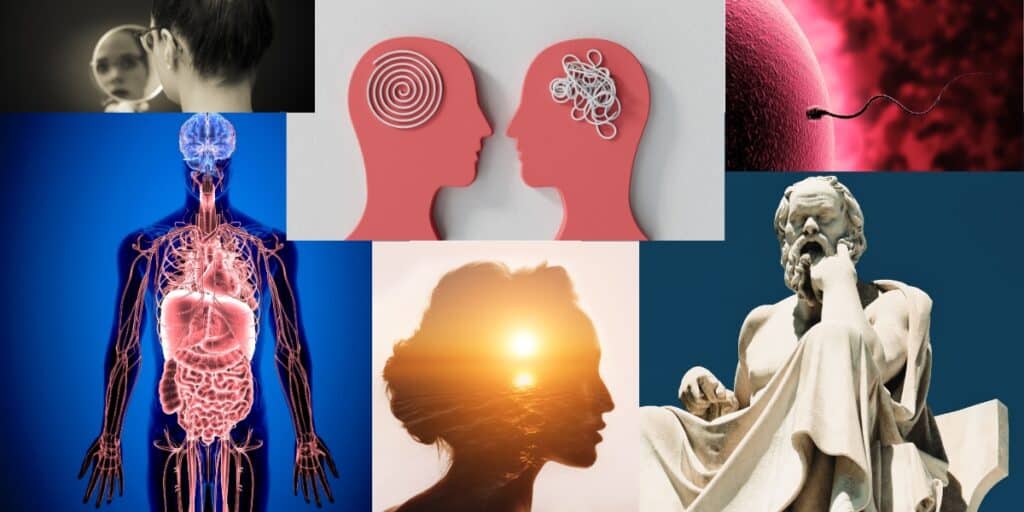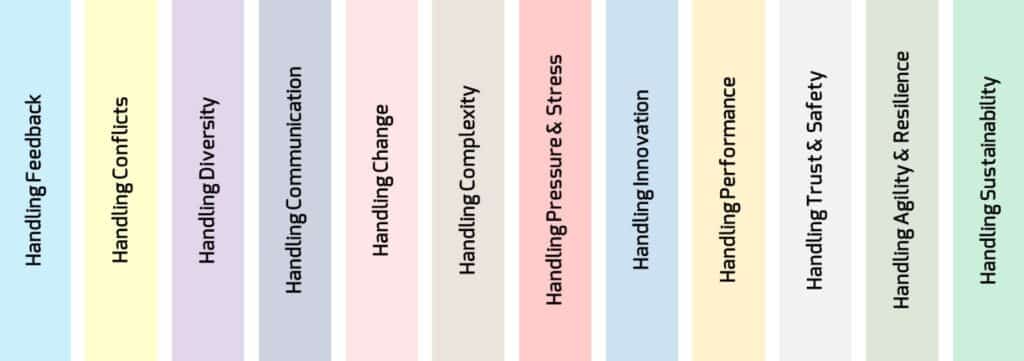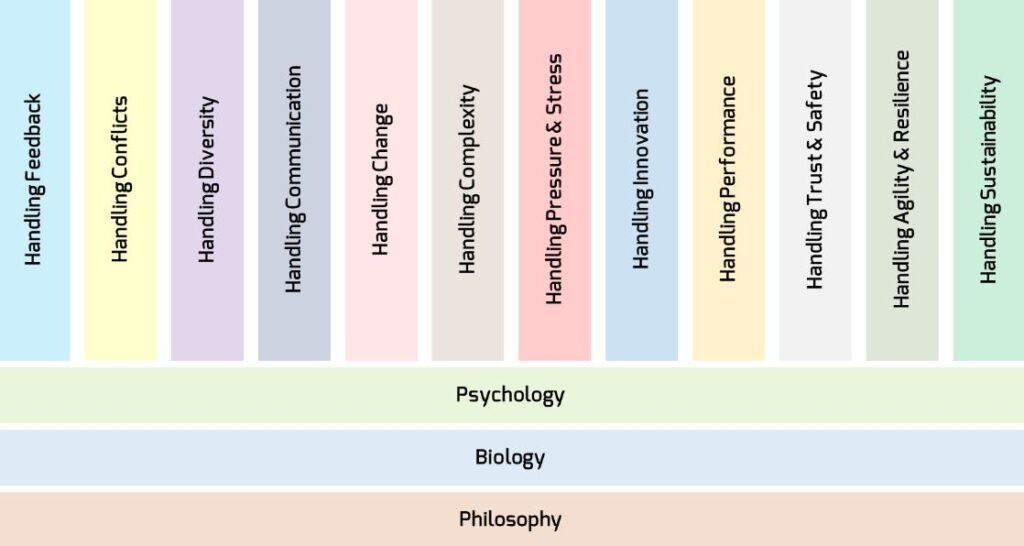The list of tools for leaders is long, and you can attend programs where you will expand your skills in building trust and emotionally safe cultures, avoiding or handling conflicts, communicating and feedback, navigating change and complexity, handling pressure and stress, empowering and building talents and taking care of innovation and entrepreneurship.
But where to start? First, let’s look at the benefits and pitfalls of using tools, and then we move into working with a mindset of understanding the conditions of being human beings.
Benefits of Using Tools
When it comes to leadership and team development, using tools can greatly enhance efficiency and productivity. These tools provide a structured approach to managing tasks, projects, and communication.
(Curious on you Enneagram Blind Type?)
By utilizing tools like communication, feedback, coaching, handling change, pressure and innovation etc., leaders can streamline processes, delegate responsibilities, and ensure smooth communication within the team. Using tools can bring several benefits:
- Structured and often proven approach.
- Further development of the tool itself.
- Clear expectations of the outcome of the specific tool – especially in comparison with using other tools.
- Less need to understand the principle, theory, and background for the tool – saving resources.
This increased efficiency allows leaders to focus their time and energy on strategic decision-making and guiding the team toward success.
Pitfalls of Using Tools
Using tools can also have some disadvantages, where wanted benefits are disappearing in trouble, misunderstandings, and wasting valuable resources.
Using tools can cause several pitfalls:
- Overreliance on the tool, as in “the tools will solve our problems”.
- Dependence on a tool, as in ” we have invested a great number of resources in this tool, so we have to use it”.
- Lack of adjustment to culture, inner and outer shifts, current dynamics etc.
- Loss of human connection due to overreliance on the tool.
- Less need to understand the principle, theory, and background for the tool – making it difficult to integrate with other areas of expertise.
Being aware of the pitfalls, leaders (and consultants) can address them proactively and make the right adjustments in time.
Using Mindsets versus Tools
In leadership and team development, there is an ongoing debate regarding the relative importance of mindsets versus tools. While tools provide structure and efficiency, it is essential to recognize the significance of mindsets in driving success. Here are a few key considerations:
Mindsets as the Foundation
Mindsets, encompassing attitudes, beliefs, and values, form the foundation of effective leadership and team development. Having the right mindset, such as open-mindedness, resilience, and a growth-oriented perspective, sets the stage for innovative thinking, adaptability, and continuous improvement. Tools, on the other hand, are merely enablers of these mindsets, serving as vehicles to aid in the manifestation of these qualities.
Mindsets Drive Tool Selection and Utilization
While tools can enhance productivity and streamline processes, mindsets play a crucial role in determining which tools are selected and how they are used. Leaders need to have a clear understanding of their team’s needs, goals, and challenges to make informed decisions about the most suitable tools. Moreover, it is the mindset of the leader that influences how effectively the chosen tools are deployed to align with the team’s unique dynamics and objectives.
Balancing Tools and Mindsets
It is essential to strike a balance between the use of tools and the cultivation of supportive mindsets. Over-reliance on tools can lead to a mechanical approach that overlooks the human aspect of leadership and team development. Conversely, emphasizing mindsets without leveraging appropriate tools may lead to inefficiencies or missed opportunities. The key lies in leveraging tools as enablers while nurturing mindsets that foster collaboration, creativity, and a growth-oriented culture.
Continuous Mindset Development
While tools can facilitate specific tasks and processes, mindsets require ongoing development and nurturing. Leaders should invest in fostering a learning mindset within themselves and their teams, encouraging continuous growth, and embracing change. This emphasis on mindsets allows leaders to adapt to new tools, overcome challenges, and inspire their teams to embrace a mindset of continuous improvement.
In summary, while tools can play a valuable role in leadership and team development, they should not overshadow the significance of mindsets.
By prioritizing the cultivation of supportive mindsets and leveraging tools as enablers, leaders can strike a balance that optimizes both efficiency and the human aspect of leadership. In this article, my aim is to introduce a mindset about the human condition, and I am also suggesting that the Enneagram can help us build such a mindset.
Understanding the condition of being a human being
I suggest looking at three aspects of what impacts or influences our leadership mastery. The first aspect is the field of psychology, which is the understanding of personality, archetypes, motivational psychology, group dynamics, stages of development, cultures, perception, cognition, emotional and social intelligence, cognitive dissonance, cognitive biases, communication, interpersonal skills, attachment styles, learning and memory, self-awareness and self-acceptance.
The second is our biology, which is the understanding of neurology and how the nervous system works, physiology and our attention to the environment, fear, anxiety and stress, instincts, somatic intelligence, gut intelligence, amygdala-hijack, health, sleep, ecology, endocrinology and how the brain wants to understand if you are a friend or enemy.
The third aspect is about philosophy, which is about existentialism, epistemology, etymology, virtues of leadership (like fairness, correctness, humility, courage, accountability, loving-kindness etc.), logic and reasoning, ethics, aesthetics and creating a sense of meaning and purpose.
Each of these aspects could seem fairly large to comprehend fully, but it is my experience that with an equal amount of study on these three aspects compared to the study of some of the tools of leadership, leaders will multiply their leadership skills dramatically.

Let’s look at a few examples on how to use these aspects of human beings in leadership.
Leadership and psychology
When we as leaders understand the psychology of human beings, we can integrate experiences about empathy, bringing the best out in others, and supporting others with positive feedback while also respecting people’s learningstyle.
Leaders can create employee- and customer loyalty through communities, building precise expectations to foster autonomy and accountability and we can use the insights from psychology to understand our own and others’ drivers for success, change and authentic pride.
Aspects of psychology are also the acceptance of outer and inner conditions. When the leader and members of the team accept their Leadership Blind Spot, Cultural Blind Spot, and Team Blind Spot, a major shift might happen in the individual and collective development.
Leadership and biology
By understanding the biology of human beings, we can integrate experiences about when to rest, how much rest is needed to avoid breakdowns, how the nervous system reacts to change through amygdala hijacks and how people bond on a biological level.
Our biology is also responsible for bonding and emotional safety between people and our bodily, emotional and cognitive intuition. The area of instincts also has a major impact on the “spirit” or “chemistry” in a team, where we naturally find other people like us relating to the same instinct and sense difficulties working with people with dissonance with our instinct.
Leadership and Philosophy
Mastering philosophy as leaders will help us reflect and understand structures of ethics, fairness, equality etc. . Also the power of balance, asking questions like “why are we doing what we are doing?”, “what is the purpose of this team?” and “what will we promise and to who?” will draw upon a philosophical perspective.
Being curious about the origin of words (etymology), common history, and Western and Eastern philosophy will help us understand why we are at the point of evolution where we are and what might be also part of the future if we continue acting like we do.
Enneagram and the Human Condition
For several decades, I have integrated the wisdom of the Enneagram in leadership and team development as the Enneagram covers different parts of the three aspects.
The original teachings of the Enneagram point toward the understanding of why we create trouble for ourselves. Each of the Enneagram types describes how we overdo our personal skills when we are out of balance somatically, emotionally, and cognitively.
As leaders, we can integrate the Enneagram in the way we motivate, inspire, guide, mentor, coach and support people around us. But first, we need to understand our own Enneagram type and thereby understand how we see the world through a specific lens that will shape our behavior into typical patterns and habits (also called an Enneagram type).
The Enneagram and Psychology
The elements in the Enneagram that relate to psychology would typically be the very creation of a type, ego or personality. It would also include areas like:
- Basic Fear
- Basic Desire
- Inner Critic
- Inner dynamic of a type (wings, arrows, levels etc.)
- Inner dynamic between different types (triggers, aversion, object relations etc.)
- Instincts when viewed as typology
The Enneagram and Biology
The elements in the Enneagram that relate to biology would typically be somatic-, emotional- and rational- intuition and every element of physical health. It would also include areas like:
- Representation of the three centers in each type
- Bonding and creating trust
- Balancing three centers
- Instincts when not view as typology
- Physical Health (rest, sleep, diet, exercise etc.)
The Enneagram and Philosophy
The elements in the Enneagram that relate to philosophy would typically be the perspective of wholeness, point and not type and virtues. It would also include areas like:
- Enneagram Virtues
- Enneagram Holy Ideas
- Understanding the Language expressing each type using Protreptic
- Creating a Sense of Meaning Using Points
- Using the Enneagram as a Mindset and not a Tool
The different elements for each of the three categories are also fluid, and the point here is not to create the precise classification but to illuminate that the Enneagram it self has a strong focus on the human condition and can, as such be a guide for leadership- and team- development.
Human Condition – Enneagram and Psychology
When using the Enneagram and Psychology in leadership development, we can focus on self-awareness, self-acceptance and self-adjustment (building new skills and handling several mindsets).
Enneagram blind spots in leadership
The Enneagram is also illuminating how we as leaders have certain blind spots depending on our Enneagram type. A blind spot is an area of our personality that we don’t want to see or acknowledge because we are not aware of them or because they are to emotionally hard to face.
When we understand one or more of our blind spots we will build more trust and emotional safety as we will show up more authentically and accepting what everybody else can see about us.
Enneagram blind types in leadership
The Enneagram will also reveal your blind type, being that of the nine type, that you do not relate to or relate very little to. Your blind type represents dormant human skills that you have not yet activated and that might create everything from a light frustration to deep aversion when others are expressing human skills.
Understanding why some other people frustrate you or even bring the worst out in you is extremely helpful in leadership. You can both avoid shaming or disconnting others and gain the benefit of human skills, that you do not master.
Human Condition – Enneagram and Biology
The biology of the Enneagram relates to creating balance in the three centers (body/somatic, heart/emotional and head/rational) and working with the Enneagram Instincts when not viewed as a typology. We can also investigate how all three centers are expressed in our type with the notion that such work could also be related to psychology.
When we practice creating balance in a center-like body/somatic, the practice is about centering and aligning the body, building a strong and agile body with a deep presence. The deep presence of the body can be practiced by breathing, physical exercises, and a physically healthy lifestyle.
Practicing creating balance in a center-like heart/emotion, the practice is about centering and aligning the heart/emotion, self-nurturing and healthy relationships. The deep presence of the heart can be practiced by heartfulness and by meditating on compassion, empathy, equanimity and sympathetic joy (The Four Brahma Viharas).
The practice of creating balance in a center-like head/rational/cognitive, the practice is about centering and aligning the mind, building a wise and agile mind with a deep presence. The deep presence of the head can be practiced by certain meditations focusing on mindfulness, openness, curiosity, direct knowing and neutral observation.
Human Condition – Enneagram and Philosophy
When integrating the Enneagram and philosophy in leadership development, we can move our attention to Enneagram Virtues and Enneagram Points (versus Enneagram Types).
When exploring our relationship with or connection to virtues like courage, fairness, loving-kindness etc. we often find that virtues are like guides that guide us to appropriate action. Each Enneagram Type has a stronger relationship or connection with a specific Enneagram Virtue that is the “center of the type”, meaning that the loss of that Enneagram Virtue creates the distraction or misperceptions of our personality.
Traditionally we use the term “Enneagram Type”, but originally there were no types but “Enneagram Points”. The points are more related to human qualities, skills, or abilities, and according to one of the early masters of the Enneagram, Oscar Ichazo, the purpose of the Enneagram was to support the practice of all the human qualities, skills or abilities from all nine point. The philosophy was to support the “complete” human being, family, society, and world.
Summary
This content explores the intersection of psychology, biology, and philosophy in the context of leadership. It delves into how understanding these disciplines can enhance leadership skills and decision-making.
My aim was to emphasize the importance of incorporating psychological insights, biological factors, and philosophical concepts into leadership practices. By integrating these diverse fields with a mindset from the Enneagram, leaders can gain a deeper understanding of human behavior, motivation, and ethical considerations, ultimately improving their effectiveness in leading others.






